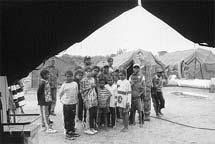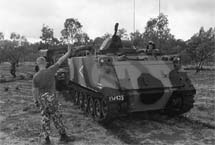Putting them back together again
While Operation Phoenix was in
action, Tennant Crrek was host to the Forward Surgical Team based at
the showgrounds. The facility, once unpacked and assembled made a hospital
complete with operating theatre.
Casualties are delivered by helicopter and one of the pilots, LieutenantMark Leo started us on our tour.
Our role is to remain on standby for any injuries or for
anyone who needs medical evacuation, in this case in the exercise area.
We are using an Iroquois helicopter - it's actually a gun ship but we've
taken the armament off it so that we can conduct AME (Aero Medical Evacuations).
We normally have a medical team who come on board and we fly out to
the casualty and back to the hospital where they will receive further
attention.
The way we work it is a crew of three - two pilots and a load master.
The load master is essentially responsible for everything that happens
in the back. Making sure of the safety of the equipment and of the people
in the back and looking after the hoist. He operates that as well. There
are two pilots in the front, one will fly and look outside and do all
that sort of stuff and the other guy will navigate and do the radio
calls. Then at some stage during the flight, whenever they like, they
swap.
We can pick up casualties without landing, the load master will get
on the hoist and he will hook up a strop to the hook and he'll lower
the hoist down to the casualty if he's in a confined area or somewhere
that makes it impossible to land. We'll hover over the area, the load
master will operate the hoist and we'll lift the patient up into the
aircraft and fly away.
Lieutenant John Barrow:
Helicopter pilot
In combat, it's a totally different situation. It's what we call "sweep
and scoop", we just land straight in, grab the patient, put them
on the aircraft and get straight back out of there again.
The preferred option is to land to get a patient instead of wrenching
them up but up here in the northern region of Australia there's usually
an LZ everywhere you go, a place for the helicopter to land, it's only
in tight areas where there's a lot of trees that they may have to winch
us down.
Lieutenant Mark Slater:
Officer in Charge of Hospital
We were ideal for the humanitarian mission that we did when we went
to Papua New Guinea. We went over and we did a lot of surgery over there
and we took some Airforce people with us as well. Then gradually over
two weeks the organisation grew until we fixed up as many people as
we could and then we came back home.
These guys spend a lot of time out on the field, for some of them it
was their first operational deployment. It's a good job, and one that
we all enjoy.
Major Len Brennen:
Officer commanding of the field surgical team.
When a casualty comes through who is seriously ill, this is where the
major procedures are done. So if their heart stops, they'll get treated
here, if they have blood in their chest, they'll have a chest tube put
in or if they can't breathe properly, they have a hole cut through for
a tracheotomy. All of the equipment is here that you need.
We've got oxygen and suction and each of these bays have the equipment
we need to do the bits and pieces. Often they've already had a doctor
hopefully at the scene and this is what we call level three. Just a
nurse goes out with the helicopter, we work in levels and the casualty
could have been injured about 500 kilometres away.
We call this a forward surgical team and in a war situation this would
be put as far forward as possible. Australia is a difficult country
because it's so big. So at the moment we've got our main hospital in
Tindal and the assumption is that the war is going to moving down this
way so the hospital has moved down to this location.
We can handle about five or six hundred kilometres between hospital,
just using helicopters. The Black Hawk helicopters have a much larger
range, they can actually go about 1000 kilometres on one tank of fuel.
If we have to move we can pack it all up in 12 hours and whatever road
time there is in between and then another 12 hours to set up again.
The packed-up containers are all moved on Mack trucks - providing we
get a crane and forklifts. They're very heavy, about 7 to 10 tonnes.
Captain Ray Gilbert:
In the theatre we have one theatre table and all the anaesthetic teams.
Any patient coming through from theatre who'd be staying here for a
period of time for immediately post-op and then would go into the ward,
would come in here for monitoring and to just check his condition so
he wakes up properly. We've got two intensive care beds with ventilators
and all the resuscitation equipment that is required, also in this shelter,
we have all our pathology equipment.
Our pathology requires an airconditioned area, so it's important for
us to have pathology here because we have a lot of pathology tests done
on ventilated patients or intensive care patients. At the Tindal Base
we had a patient on a ventilator, one of the local people from around
Mataranka. We have to be self sufficient as far as our resuscitation
and maintenance of someone who has been injured.
All the equipment is stored in these little boxes, it's a bit of an
art really. They are then tied down and all these walls then come in.
When we were deployed up to Bouganville at the beginning of this year,
we had quite a few people being ventilated. We had a hospital facility
set up there.
Just what you'd have in an ordinary intensive care unit in a civilian
hospital, the components are all here. We have to provide immediate
first aid to a casualty, if they need to be resuscitated and sent to
theatre then we'd do that and maintain them in an intensive care area.
It takes time to organise transport to a civilian hospital, so it might
be up to 12 hours maximum before we can get them out. There's also a
RAAF AME team that's here. They prepare a patient ready for transport,
so once the Hercules comes in, they're all ready to go. We have to very
conscious that we can be deployed anywhere in Australia or overseas
and to very remote areas.
Rain, rain, go away; it's far too wet for us to play. Ever mindful
of its obligation to rectify any environmental damage caused by wargames,
the army cut short its recent exercise in the Barkly due to the short,
sharp wet.
The country around Tennant Creek has had little rain for nearly two
years and the first good downpour turned hard ground into bog overnight.
The drivers of the trucks parked at the Showground found that even a
six-wheel-drive vehicle was not enough to conquer the sudden quagmire.
Further to the north, army units on the way south from Tindal were horrified
when they saw the damage that even one tank was making of the soft groundcover.
The cost of repairing the damage that a full-scale armoured exercise
would wreak was deemed to be far greater than the benefit.
While they were in town the army delighted lots of school kids with
their open days. Many children were able to climb through armoured vehicles,
sit in helicopters and check out the full field hospital.
When the time came to pull out, the Central Land Council arranged with
the army for some Warumungu elders to go aloft to see for themselves
that no damage had been done to Tennant Creek and surrounding lands.

Bringing in the casualties.

Local school students
about to see the workings of the recovery tents.

What they saw inside.

Inside the operating
theatre (L-R): Leading Aircraftsman Lucchini, Leading Aircraftswoman Sheather,
Staff Sergeant Cole and Corporal Jennings. Under the sheet lay the unknown
soldier.


Some of the many kids
who clambered in around and over the machinery.


Kathleen Fitz and
Edith Graham belt up before their flight.